Study on Tourism Flow Network Patterns on May Day Holiday
Abstract
:1. Introduction
2. Literature Review
2.1. Research Progress
2.2. Theoretical Basis
3. Materials and Methods
3.1. Data Sources and Processing
3.2. Analytical Methods
4. Results
4.1. The Asymmetry of the Flow Potential of Tourist Destinations and Origins
4.2. Complexity of Tourism Flow Networks
4.3. Differentiation of Tourism Flow Networks
4.3.1. Tourism Flow Network Resulting from Air Transport
4.3.2. Tourism Flow Network Resulting from Rail Transport
4.3.3. Tourism Flow Network Resulting from Road Transport
5. Discussion
6. Conclusions
Author Contributions
Funding
Institutional Review Board Statement
Informed Consent Statement
Data Availability Statement
Conflicts of Interest
References
- Yang, Y. The effect of social interaction and tourism scenario on tourism demand: Empirical research based on spring festival golden week. Tour. Trib. 2016, 31, 56–69. [Google Scholar]
- Jun, Y. Rational regression of golden weeks tourism. Tour. Sci. 2005, 19, 48–51. [Google Scholar]
- Li, Y. A study summary on the problems existing in dolden week holiday tourism and countermeasures. Tour. Trib. 2006, 21, 12–18. [Google Scholar]
- Wen, J.; Kozak, M.; Yang, S.; Liu, F. COVID-19: Potential effects on Chinese citizens’ lifestyle and travel. Tour. Rev. 2020. [Google Scholar] [CrossRef]
- Fyall, A.; Garrod, B. Destination management: A perspective article. Tour. Rev. 2019, 75, 165–169. [Google Scholar] [CrossRef]
- Sheng, W. From “tourist gaze” to “tourist gaze”: Cultural logic of “golden week”. CHN Book Rev. 2018, 4, 27–34. [Google Scholar]
- Qin, Y.; Gu, H.; Li, B.; Fan, D. The Chinese hospitality industry: A perspective article. Tour. Rev. 2019, 75, 117–121. [Google Scholar] [CrossRef]
- Sánchez-Fernández, M.D.; Álvarez-Bassi, D.; Ramón-Cardona, J. Management of tourist destinations: The expectations of guests on eWOM generation in Maldonado (Uruguay). Sustainability 2020, 12, 6825. [Google Scholar] [CrossRef]
- Pulido-Fernández, J.I.; Casado-Montilla, J.; Carrillo-Hidalgo, I. Understanding the behaviour of olive oil tourists: A cluster analysis in Southern Spain. Sustainability 2020, 12, 6863. [Google Scholar] [CrossRef]
- Zhang, H.; Gordon, S.; Buhalis, D.; Ding, X. Experience value cocreation on destination online platforms. J. Travel Res. 2018, 57, 1093–1107. [Google Scholar] [CrossRef]
- Wu, H.; Lv, X.; Cavusoglu, M.; Cobanoglu, C. Chinese cruise customers loyalty: The impact of customer participation and service personal values. Tour. Rev. 2020. [Google Scholar] [CrossRef]
- Shen, K.; Shen, H. Chinese traditional village residents’ behavioural intention to support tourism: An extended model of the theory of planned behaviour. Tour. Rev. 2020. [Google Scholar] [CrossRef]
- Chen, H. Conceptual definition of tourism flow and new discussion on the theoretic connotation. Tour. Res. 2017, 9, 22–31. [Google Scholar]
- Lee, S.H.; Choi, J.Y.; Yoo, S.H.; Oh, Y.G. Evaluating spatial centrality for integrated tourism management in rural areas using GIS and network analysis. Tour. Manag. 2013, 34, 14–24. [Google Scholar] [CrossRef]
- Fafchamps, M.; Goyal, S.; Van der Leij, M. Matching and network effects. J. Eur. Econ. Assoc. 2010, 8, 203–231. [Google Scholar] [CrossRef]
- Baggio, R. The science of complexity in the tourism domain: A perspective article. Tour. Rev. 2019, 75, 16–19. [Google Scholar] [CrossRef]
- Ayazlar, R.A. Flow phenomenon as a tourist experience in paragliding: A qualitative research. Procedia Econ. Financ. 2015, 26, 792–799. [Google Scholar] [CrossRef] [Green Version]
- Yin, P.; Lin, Z.; Prideaux, B. The impact of high-speed railway on tourism spatial structures between two adjoining metropolitan cities in China: Beijing and Tianjin. J. Trans. Geogr. 2019, 80, 102495. [Google Scholar] [CrossRef]
- Alderighi, M.; Gaggero, A.A. Flight availability and international tourism flows. Ann. Tour. Res. 2019, 79. [Google Scholar] [CrossRef]
- Mou, N.; Yuan, R.; Yang, T.; Zhang, H.; Tang, J.; Makkonen, T. Exploring spatio-temporal changes of city inbound tourism flow: The case of Shanghai, China. Tour. Manag. 2020, 76, 103955. [Google Scholar] [CrossRef]
- Jin, C.; Xu, J.; Huang, Z. Spatiotemporal analysis of regional tourism development: A semiparametric geographically weighted regression model approach. Habitat Int. 2019, 87, 1–10. [Google Scholar] [CrossRef]
- Wang, D.; Niu, Y.; Qian, J. Evolution and optimization of China’s urban tourism spatial structure: A high speed rail perspective. Tour. Manag. 2018, 64, 218–232. [Google Scholar] [CrossRef]
- Zhong, S.; Jie, Z.; Xiang, L. A reformulated directional bias of tourism flow. Tour. Geogr. 2011, 13, 129–147. [Google Scholar] [CrossRef]
- Liu, P.; Zhang, H.; Zhang, J.; Sun, Y.; Qiu, M. Spatial-temporal response patterns of tourism flow under impulse pre-trip information search: From online to arrival. Tour. Manag. 2019, 73, 105–114. [Google Scholar] [CrossRef]
- Li, Y.; Zhou, B.; Wang, L.; Cheng, S. Effect of tourist flow on province-scale food resource spatial allocation in China. J. Clean. Prod. 2019, 239, 117931. [Google Scholar] [CrossRef]
- Yang, Y.; Zhang, H. Spatial-temporal forecasting of tourism demand. Ann. Tour. Res. 2019, 75, 106–119. [Google Scholar] [CrossRef]
- Song, H.; Qiu, R.T.Q.; Park, J. A review of research on tourism demand forecasting: Launching the annals of tourism research curated collection on tourism demand forecasting. Ann. Tour. Res. 2019, 75, 338–362. [Google Scholar] [CrossRef]
- Yao, M.; Chen, Y.; Zhou, Z. The evolution of structural features and gravity enter for China-ASEAN tourism flow network. Eco. Geogr. 2018, 38, 181–189. [Google Scholar]
- Scott, N.; Cooper, C.; Baggio, R. Destination networks: Four Australian cases. Ann. Tour. Res. 2008, 35, 169–188. [Google Scholar] [CrossRef]
- Chua, A.; Servillo, L.; Marcheggiani, E.; Moere, A.V. Mapping cilento:using geotagged social media data to characterize tourism flows in southern Italy. Tour. Manag. 2016, 57, 295–310. [Google Scholar] [CrossRef]
- Buhalis, D.; Harwood, T.; Bogicevic, V.; Viglia, G.; Beldona, S.; Hofacker, C. Technological disruptions in services: Lessons from tourism and hospitality. J. Serv. Manag. 2019, 30, 484–506. [Google Scholar] [CrossRef]
- Buhalis, D. Technology in tourism-from information communication technologies to eTourism and smart tourism towards ambient intelligence tourism: A perspective article. Tour. Rev. 2019, 75, 267–272. [Google Scholar] [CrossRef]
- Brás, J.M.; Costa, C.; Buhalis, D. Network analysis and wine routes: The case of the Bairrada wine route. Serv. Ind. J. 2010, 30, 1621–1641. [Google Scholar] [CrossRef]
- Xu, M.; Huang, Z.F.; Cao, F.D.; Zhu, H.Z. The network structure features and influence factors of tourism flows based on online data analysis: Taking the Yangtze river delta region as an example. Econ. Geogr. 2018, 38, 193–202. [Google Scholar]
- Lohmann, G.; Pereira, B.A. Air transport innovations: A perspective article. Tour. Rev. 2019, 75, 95–101. [Google Scholar] [CrossRef] [Green Version]
- Duval, D.T. Transport and tourism: A perspective article. Tour. Rev. 2020, 75, 91–94. [Google Scholar] [CrossRef]
- Froidh, O. Perspectives for a future high-speed train in the Swedish domestic travel market. J. Transp. Geogr. 2008, 16, 268–277. [Google Scholar] [CrossRef]
- Li, M.; Chen, J. High-speed rail network in China: The contribution of fast trains to regional tourism and economic development. Tour. Rev. 2019, 75, 414–432. [Google Scholar] [CrossRef]
- Degen, W.; Tian, C.; Lin, L.; Li, W.; Lew, A.A. Mechanism and HSR effect of spatial structure of regional tourism flow: Case study of Beijing-Shanghai HSR in China. Acta Geogr. Sin. 2015, 70, 214–233. [Google Scholar]
- Wang, Z.; Xu, S. Influence and evaluation of different traffic modes on tourism efficiency: Taking Zhangjiajie as an example. Sci. Geogr. Sin. 2018, 38, 1148–1155. [Google Scholar]
- Degen, W. The influence of Beijing-Shanghai high-speed railway on tourism flow and time-space distribution. Tour. Trib. 2014, 29, 75–82. [Google Scholar]
- Jiang, H.; Liu, J.; Jiang, J. An analysis of the accessibility of China’s tourist attractions under the impact of high-speed railway. Tour. Trib. 2014, 29, 58–67. [Google Scholar]
- Liu, F.; Zhang, J.; Chen, D. Application of social network analysis in tourism research. Tour. Forum 2009, 2, 172–177. [Google Scholar]
- Dredge, D. Destination place planning and design. Ann. Tour. Res. 1999, 26, 772–791. [Google Scholar] [CrossRef]
- Zhong, S.; Zhang, J.; Han, G.-S. Satial pattern of tourism flow: Problem and prospects. Human Geogr. 2010, 5, 31–36. [Google Scholar]
- Lundgren, J.O.J. The tourist frontier of Nouveau Quebec: Functions and regional linkages. Tour. Rev. 1982, 37, 10–16. [Google Scholar] [CrossRef]
- Morrison, P.; Lynch, N.J. International tourism networks. Int. J. Contemp. Hosp. Manag. 2004, 16, 197–202. [Google Scholar] [CrossRef]
- Liu, F.; Zhang, J.; Zhang, J.; Chen, D.; Zhong, S.; Zhang, H.; Liu, Z. Analysis on basic methods of spatial data acquisition of tourism flow: A review and comparison of domestic and foreign research. Tour. Trib. 2012, 27, 101–109. [Google Scholar]
- Deasy, G.F.; Griess, P.R. Impact of a tourist facility on its hinterland. Ann. Assoc. Am. Geogr. 1966, 56, 290–306. [Google Scholar] [CrossRef]
- Yang, X.Z.; Gu, C.L.; Wang, Q. Urban tourism flow network structure construction in Nanjing. Acta Geogr. Sin. 2007, 62, 609–620. [Google Scholar]
- Yu, H.; Xu, X.; Feng, X. The impact of Shanghai Disneyland on Shanghai’s tourist flow network: From the perspective of tourists’digital footprints on the Lvmama website. Tour. Trib. 2018, 33, 33–45. [Google Scholar]
- Fu, Q.G.; Liu, D.J.; Hu, J. Network structure and optimization research on the Hubei province tourist flow. Econ. Geogr. 2015, 35, 191–196. [Google Scholar]
- Liu, H.; Wei, L.; Zhang, J. The research on the characteristics of network structure of aera tourism flows based on tourism route. Hum. Geogr. 2014, 29, 131–136. [Google Scholar]
- Ji, X.; Ge, Y.; Chen, F. Spatiotemporal differentiation characteristics of holiday tourism flow based on big data of highway traffic flow: A case study of seven holidays in Yunnan province in 2017. J. Tour. 2019, 34, 37–47. [Google Scholar]
- Wu, L.; Jiao, H.; Ye, L. Spatiotemporal characteristics of coupling and coordinated development of tourism economy and transportation in Wannan international cultural tourism demonstration zone. Geogr. Sci. 2019, 39, 1822–1829. [Google Scholar]
- Wang, Z.; Zhao, S.; Yang, X. Study on the coupling and coordinated evolution of transportation network and tourism destination of Urban agglomeration: A case study of Changsha Zhuzhou Xiangtan urban agglomeration. World Geogr. Res. 2020, 29, 962–972. [Google Scholar]
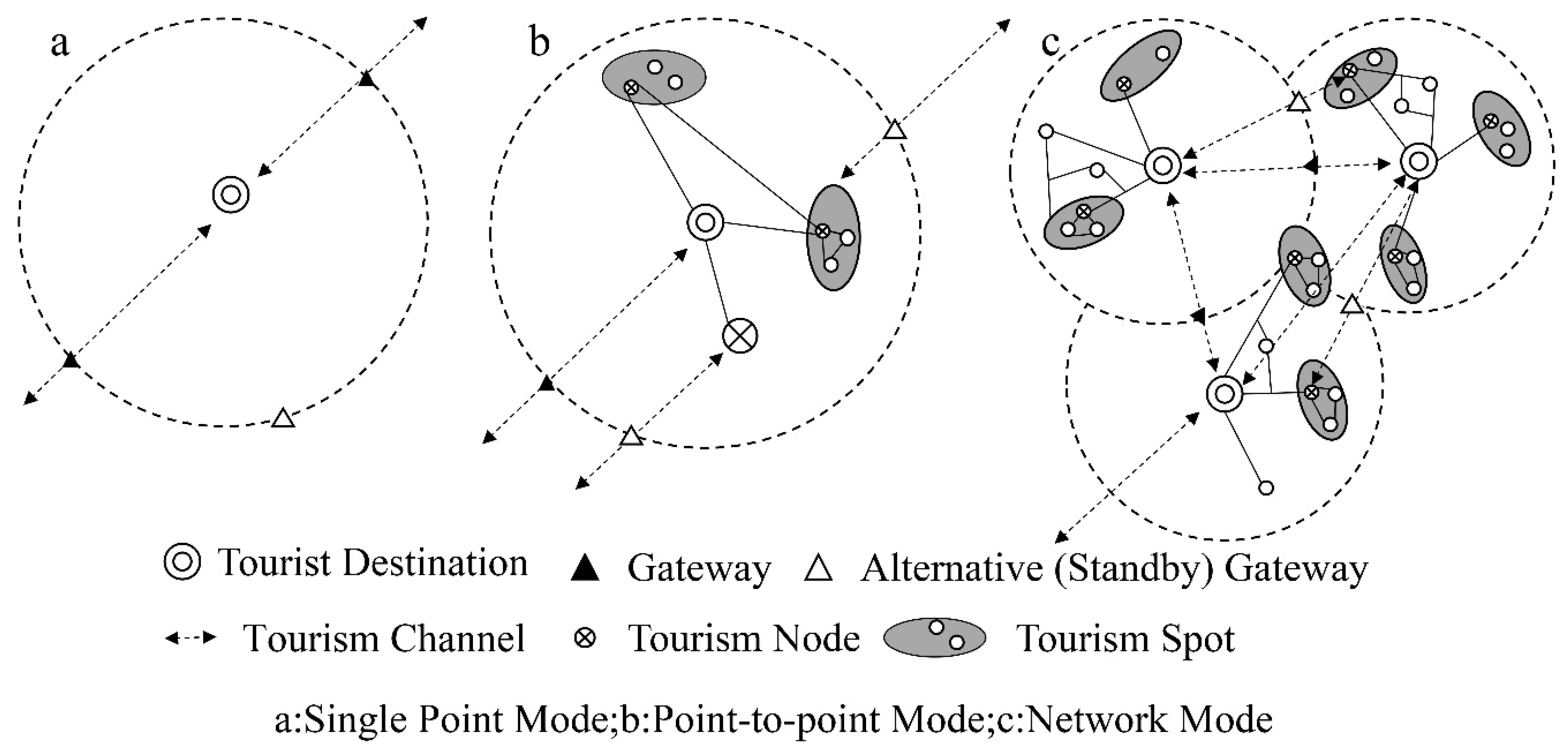

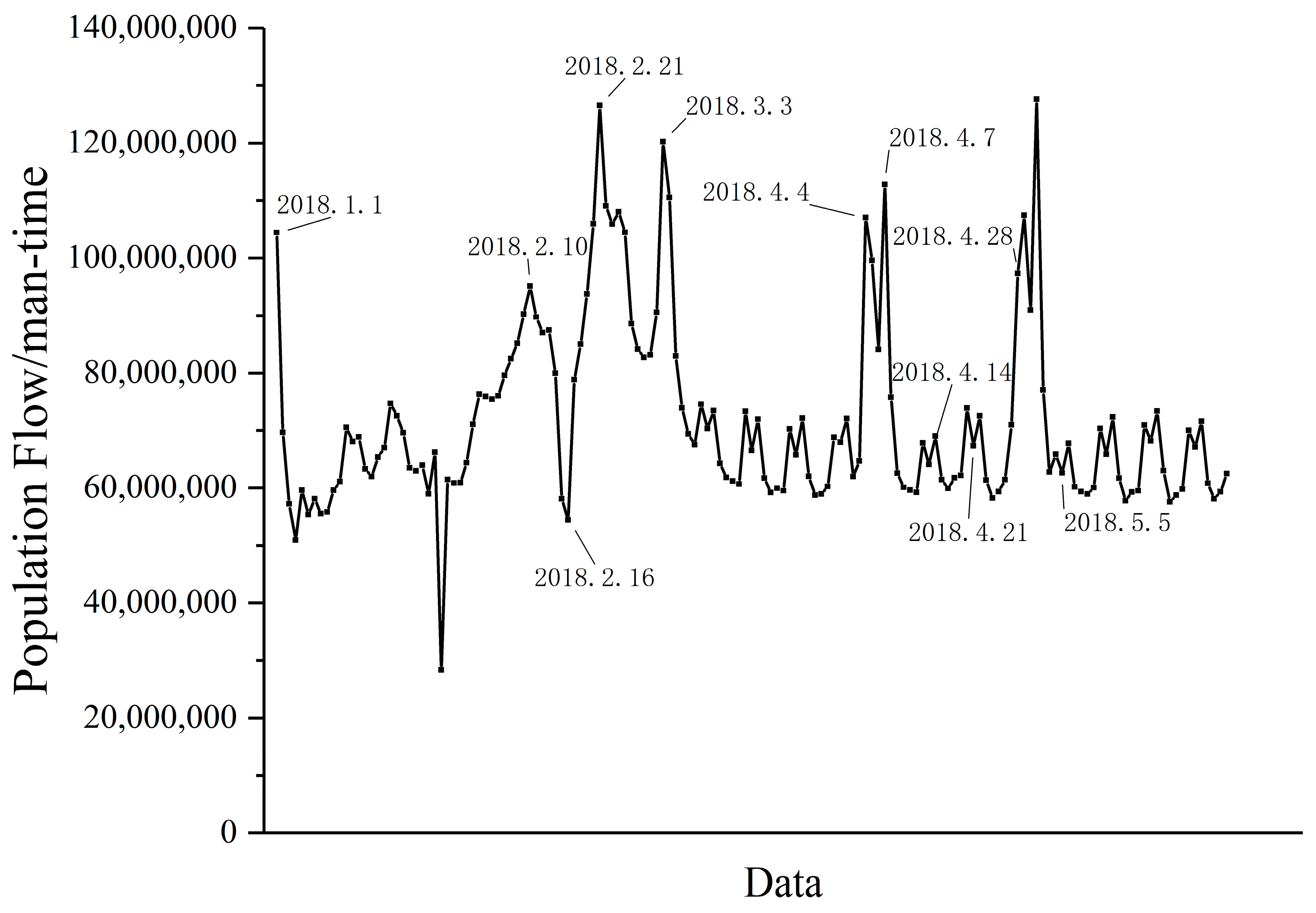

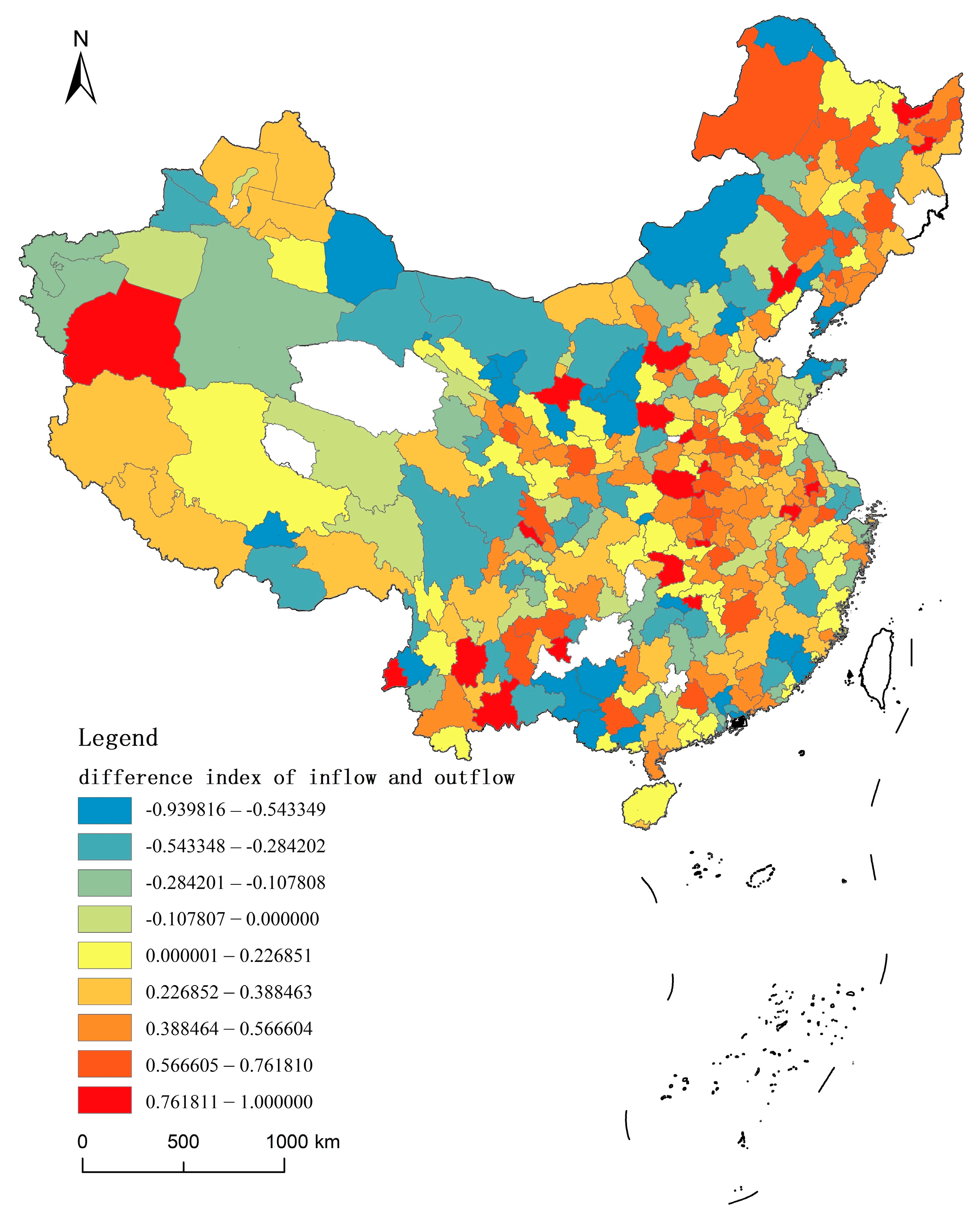
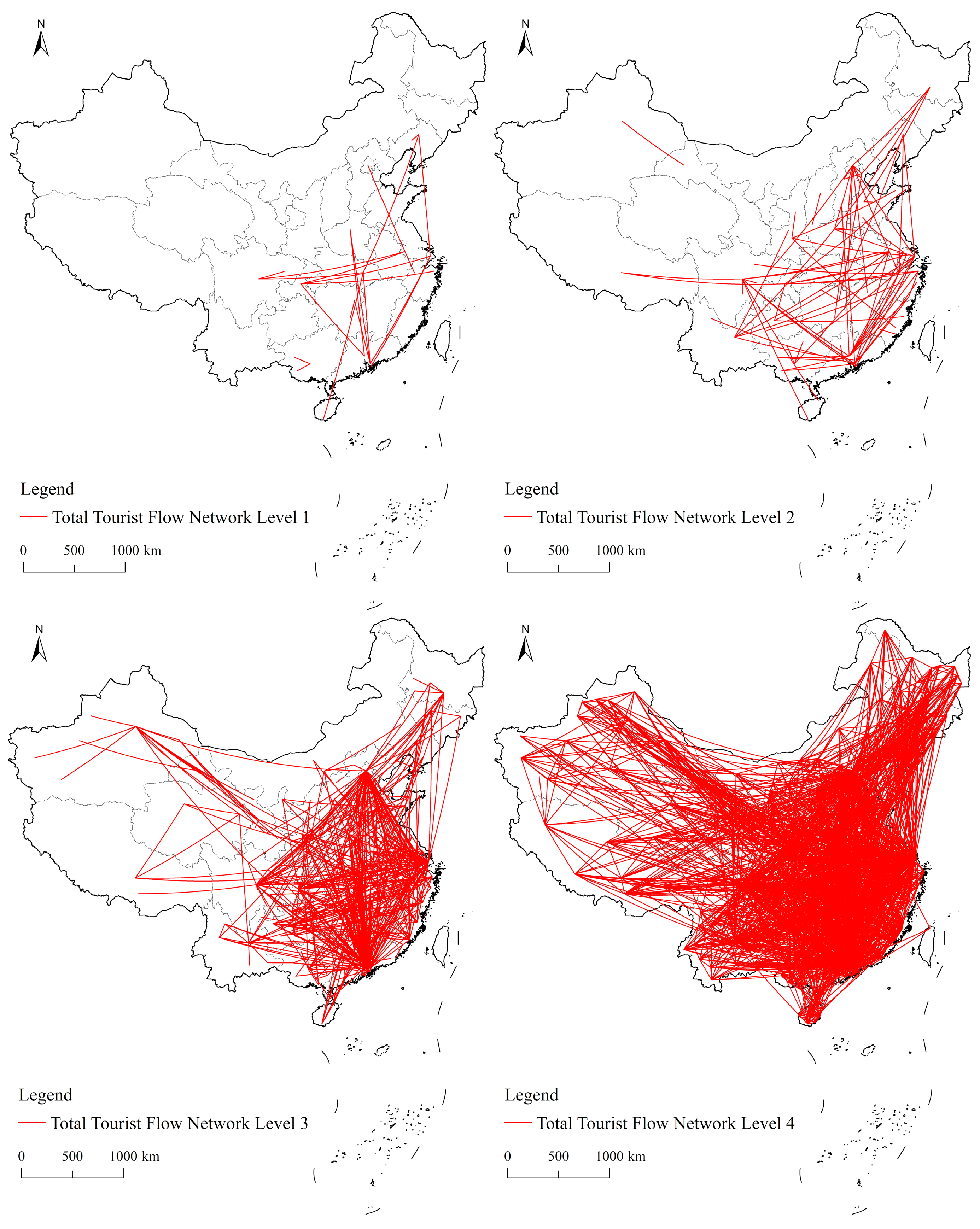
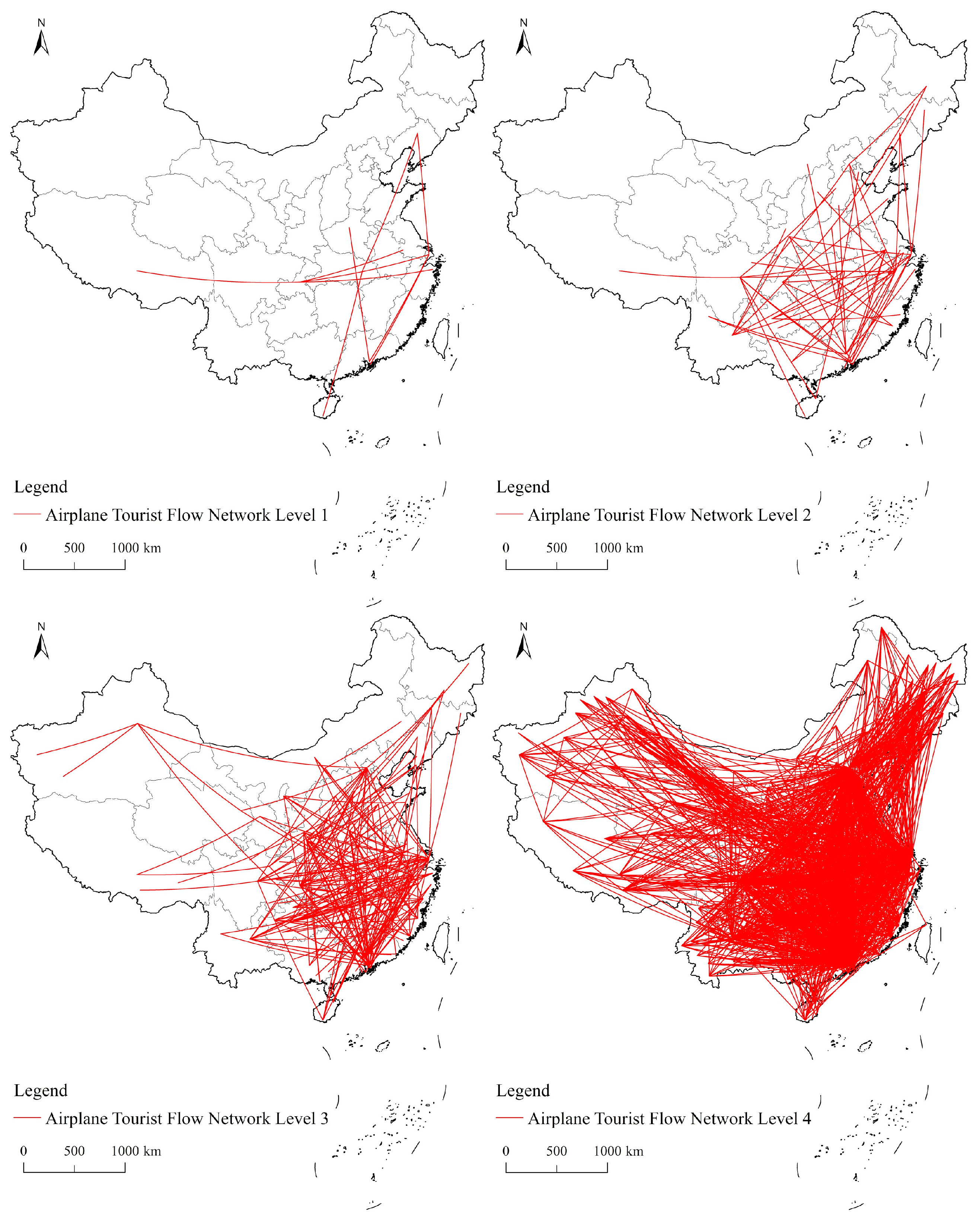
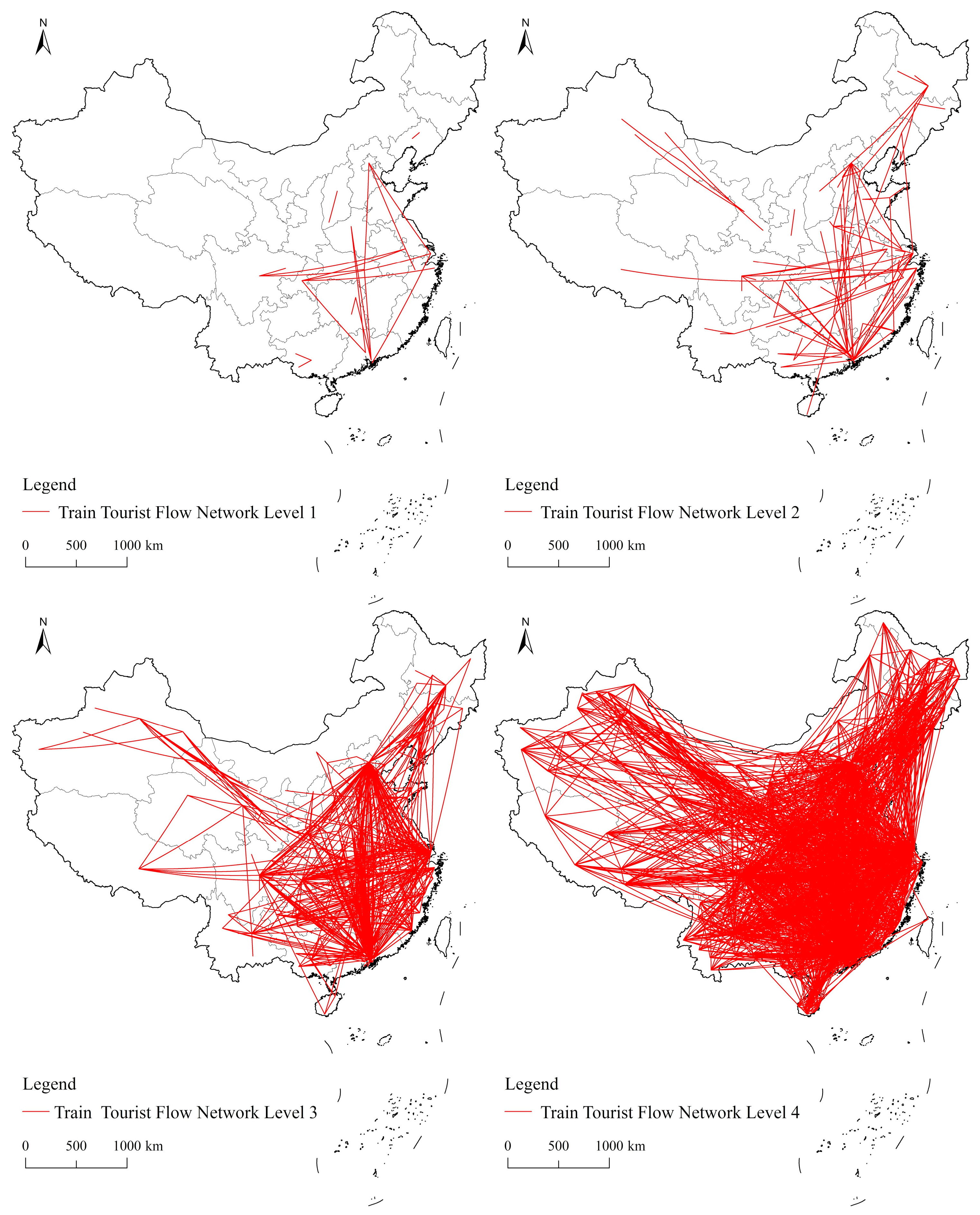
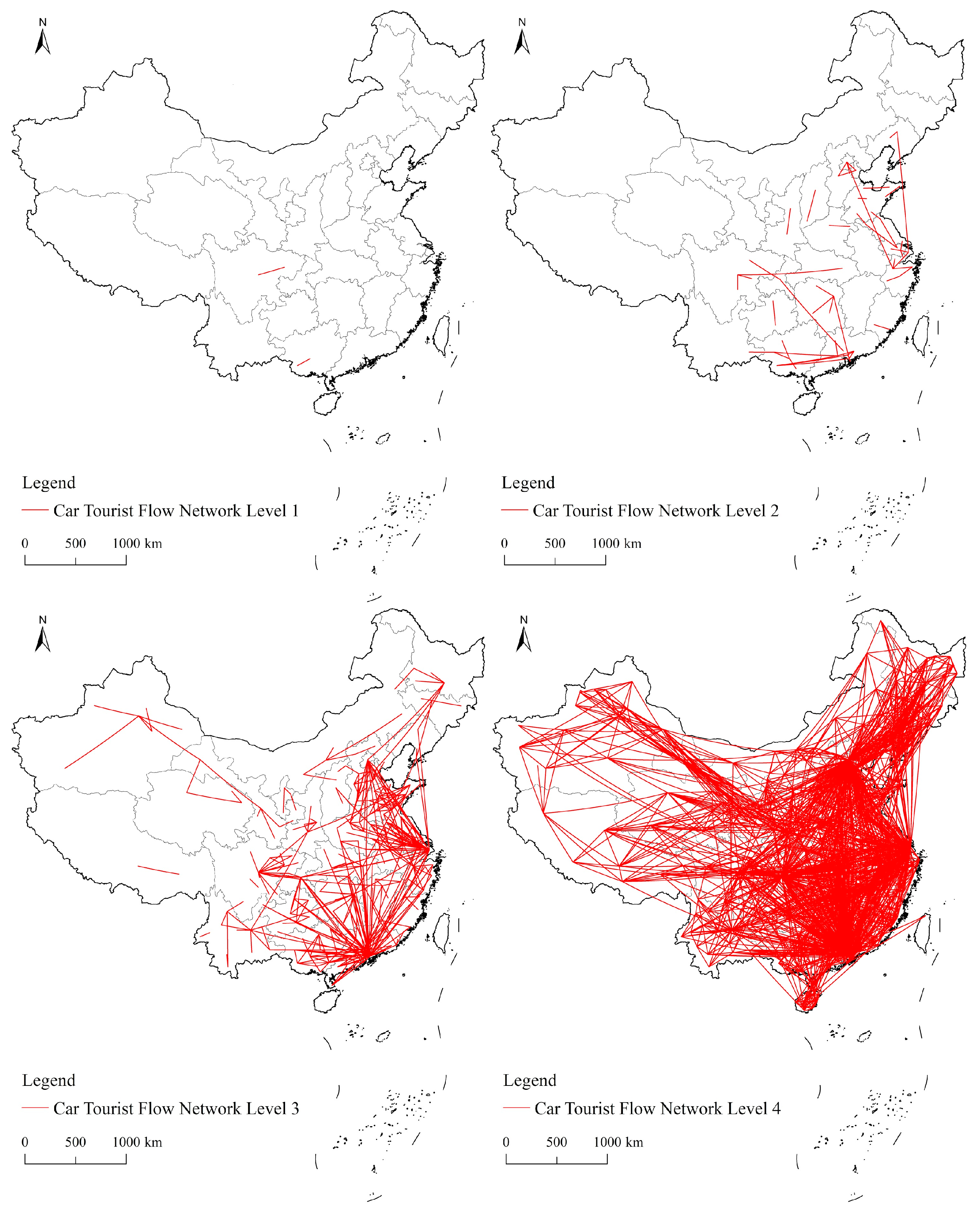
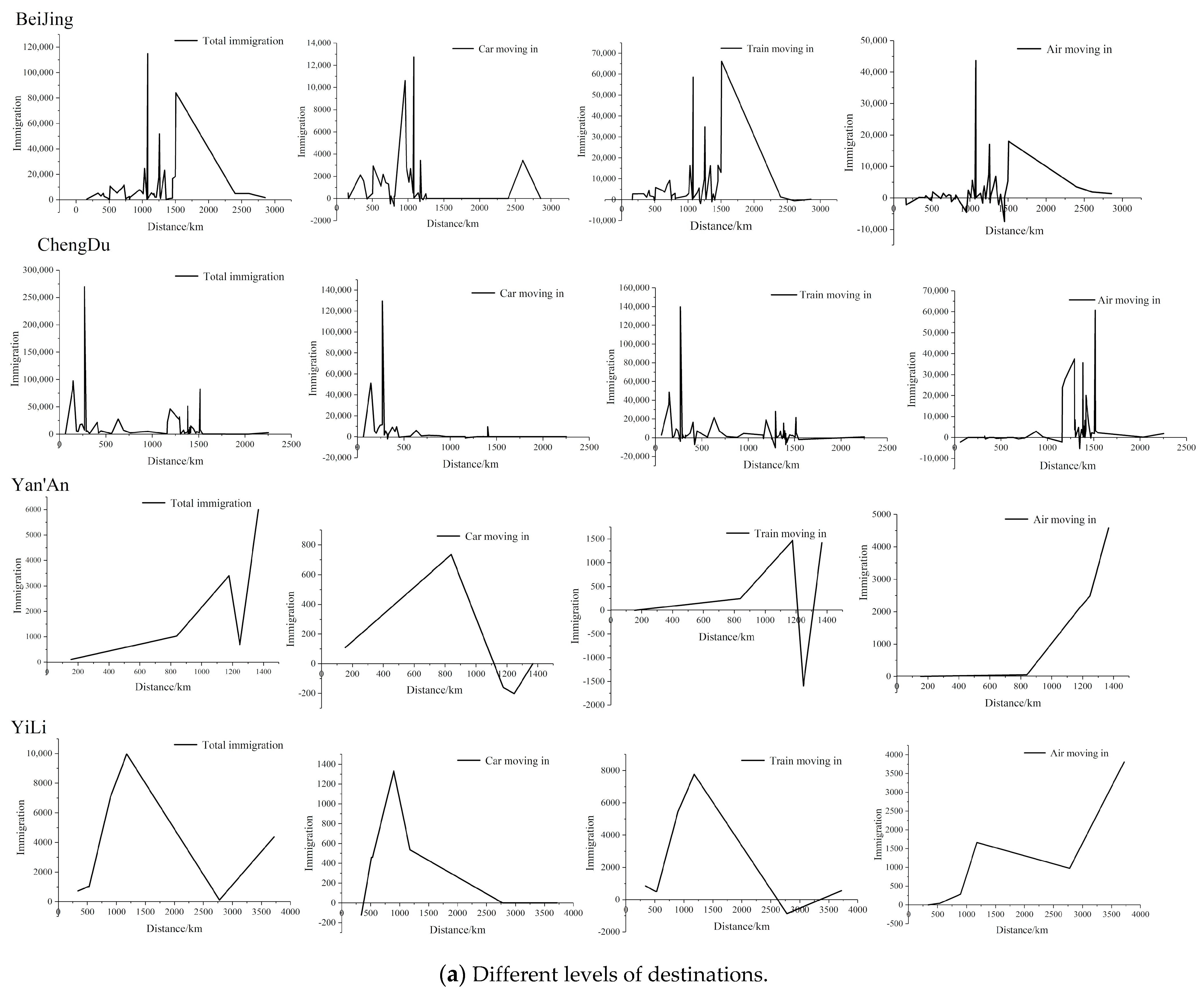

| Urban-Type | Correlation | Tourist Attractions and Receptivity | Travel Power | ||||||
|---|---|---|---|---|---|---|---|---|---|
| Number of 5A Scenic Spots | Number of 4A Scenic Spots | Number of 3A Scenic Spots | Number of 5-Star Hotels | Number of 4-Star Hotels | Number of 3-Star Hotels | Per Capita Disposable Income | |||
| D&O Type | Inflow | Pearson Relevance | 0.17 | −0.645 | −0.313 | 0.155 | 0.508 | 0.543 | −0.554 |
| Significant (bilateral) | 0.688 | 0.084 | 0.45 | 0.713 | 0.199 | 0.165 | 0.155 | ||
| Outflow | Pearson Relevance | 0.334 | 0.209 | −0.67 | 0.770* | 0.594 | 0.537 | 0.516 | |
| Significant (bilateral) | 0.419 | 0.619 | 0.069 | 0.025 | 0.121 | 0.17 | 0.191 | ||
| D Type | Pearson Relevance | 0.358 ** | 0.440 ** | 0.340 ** | 0.481 ** | 0.444 ** | 0.423 ** | 0.439 ** | |
| Significant (bilateral) | 0 | 0 | 0 | 0 | 0 | 0 | 0 | ||
| O Type | Pearson Relevance | 0.205 | 0.350 ** | 0.473 ** | 0.369 ** | 0.357 ** | 0.414 ** | 0.268 * | |
| Significant (bilateral) | 0.076 | 0.002 | 0 | 0.001 | 0.002 | 0 | 0.019 | ||
| Network Type | Network Level (Number of Tourism Paths) | Average Flow Distance/km | Average Flow/Man-Time |
|---|---|---|---|
| Total Tourism Flow Network | Level 1 (22) | 962.719 | 192,207 |
| Level 2 (99) | 884.161 | 68,592 | |
| Level 3 (611) | 780.068 | 23,005 | |
| Level 4 (2961) | 692.529 | 3937 | |
| Car Tourism Flow Network | Level 1 (2) | 205.391 | 151,239 |
| Level 2 (51) | 288.383 | 30,077 | |
| Level 3 (446) | 352.346 | 8299 | |
| Level 4 (2400) | 526.403 | 1259 | |
| Train Tourism Flow Network | Level 1 (23) | 883.668 | 102,436 |
| Level 2 (105) | 723.774 | 36,223 | |
| Level 3 (546) | 770.402 | 13,501 | |
| Level 4 (2984) | 700.906 | 2205 | |
| Airplane Tourism Flow Network | Level 1 (130) | 1357.117 | 111,787 |
| Level 2 (60) | 1264.463 | 41,255 | |
| Level 3 (206) | 1303.694 | 14,557 | |
| Level 4 (1674) | 1140.207 | 1791 |
Publisher’s Note: MDPI stays neutral with regard to jurisdictional claims in published maps and institutional affiliations. |
© 2021 by the authors. Licensee MDPI, Basel, Switzerland. This article is an open access article distributed under the terms and conditions of the Creative Commons Attribution (CC BY) license (http://creativecommons.org/licenses/by/4.0/).
Share and Cite
Wu, S.; Wang, L.; Liu, H. Study on Tourism Flow Network Patterns on May Day Holiday. Sustainability 2021, 13, 947. https://doi.org/10.3390/su13020947
Wu S, Wang L, Liu H. Study on Tourism Flow Network Patterns on May Day Holiday. Sustainability. 2021; 13(2):947. https://doi.org/10.3390/su13020947
Chicago/Turabian StyleWu, Shanshan, Lucang Wang, and Haiyang Liu. 2021. "Study on Tourism Flow Network Patterns on May Day Holiday" Sustainability 13, no. 2: 947. https://doi.org/10.3390/su13020947







